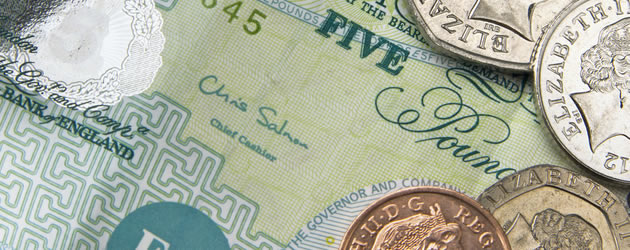UPDATE
The Pound Sterling to Euro (GBP/EUR) exchange rate softened by around -0.6%, whilst the Pound Sterling to US Dollar (GBP/USD) exchange rate cooled by around -0.4% on Tuesday morning.
In response to disappointing economic data, which showed British construction output slowed beyond expectations, the Pound softened versus the Euro and the US Dollar.
The single currency appreciated after Eurozone and German unemployment bettered expectations, whilst the US Dollar has found support thanks to safe-haven demand.
The Pound Sterling to Euro (GBP/EUR) exchange rate is currently trending in the region of 1.3165.
The Pound Sterling to US Dollar (GBP/USD) exchange rate is currently trending in the region of 1.4370.
Yesterday…
Pound Sterling to Euro (GBP/EUR) Exchange Rate Forecast to Strengthen as ECB Not Expected to Follow Japan
The Pound Sterling to Euro (GBP/EUR) exchange rate climbed by around 0.3% on Monday afternoon.
In response to better-than-expected domestic data, the British Pound advanced versus nearly all of its major peers. Of particular significance, in terms of improving Sterling trader sentiment, was rising factory output. The Markit/CIPS UK Manufacturing PMI was predicted to fall from 52.1 to 51.6 on a seasonally adjusted basis, but January’s actual result unexpectedly rose to 52.9. This suggests that British first-quarter growth in 2016 won’t emulate that of the fourth-quarter in 2015 insomuch as the services sector may not be the only driver of growth.
The Pound Sterling to Euro (GBP/EUR) exchange rate is currently trending in the region of 1.3193.
Although Eurozone factory output met with expectations of a slowdown, the Euro held gains versus most of its major peers. January’s Eurozone Manufacturing PMI met with the median market forecast drop from 53.2 to 52.3. Demand for the single currency has remained high as traders speculate that the European Central Bank’s (ECB) proposed easing in March will not be nearly as aggressive as had been seen by the Bank of Japan (BoJ) last Friday.
‘The data’s not so bad that you’re forced to expect the ECB to be super expansionary,’ said Esther Reichelt, a Frankfurt-based currency strategist at Commerzbank AG. ‘After the disappointment in December, markets are very cautious about what to expect from the ECB, even if they are sounding dovish. The market is reluctant to price in too much because it hurt them in December.’
Pound Sterling to US Dollar (GBP/USD) Conversion Rate Predicted to Advance ahead of US Core Personal Consumption Expenditure
The Pound Sterling to US Dollar (GBP/USD) exchange rate strengthened by around 0.8% on Monday afternoon.
Commenting on the British manufacturing data Rob Dobson, Senior Economist at survey compilers Markit, stated: ‘The UK manufacturing sector registered an uptick in its rate of expansion at the start of 2016, shrugging off a number of potential headwinds, ranging from global financial market volatility to localised flooding in the North of the country. The domestic market remains the key growth driver. In contrast, the trend in new export orders continues to disappoint, falling back into reverse gear in January. Even after recent easing in the exchange rate, a number of manufacturers are still finding that the strength of the Pound against the Euro is impacting order inflows. Reports from companies also highlight how the general operating environment has become increasingly competitive both at home and abroad as firms scramble to win new customers.’
The Pound Sterling to US Dollar (GBP/USD) exchange rate is currently trending in the region of 1.4358.
Despite heightened safe-haven demand, after manufacturing in China registered a record sixth-consecutive month of contraction, the US Dollar softened versus a number of its major peers. The depreciation is partly the result of a comparatively strong Euro, but is also in response to speculation that US manufacturing output will be weak. January’s ISM Manufacturing data is predicted to rise from 48.0 to 48.5, holding well below the 50 mark which separates growth from contraction. December’s Core Personal Consumption Expenditure will also be of significance in terms of the potential to stimulate US Dollar volatility today.
Pound Sterling Forecast: BoE ‘Super Thursday’ to Dominate Trader Focus This Week
Although there will be a number of influential domestic data publications ahead of ‘Super Thursday’ (the term used to describe the Thursday which includes the Bank of England (BoE) interest rate decision, meeting minutes and inflation report) trader focus is likely to be dominated by news from the central bank. Whilst BoE policymakers are not expected to change policy outlook at this time, the accompanying meeting minutes may give some indication as to outlook. The inflation report will be very significant given that low consumer prices have been repeatedly cited as one on the main reasons for keeping monetary policy ultra-accommodative. Although ‘Super Thursday’ will be significant, the Pound is also likely to see movement in response to Tuesday’s Construction PMI and Wednesday’s Services PMI.
Tuesday is likely to see Euro volatility with the ECB Economic Bulletin and the Markit Composite and Services PMIs due for release. For those invested in the US Dollar, Tuesday’s ADP Employment Change and ISM Non-Manufacturing PMI will both be watched closely.
The Pound Sterling to Euro (GBP/EUR) exchange rate was trending within the range of 1.3108 to 1.3201.
The Pound Sterling to US Dollar (GBP/USD) exchange rate was trending within the range of 1.4233 to 1.4379 during Monday’s European session.



